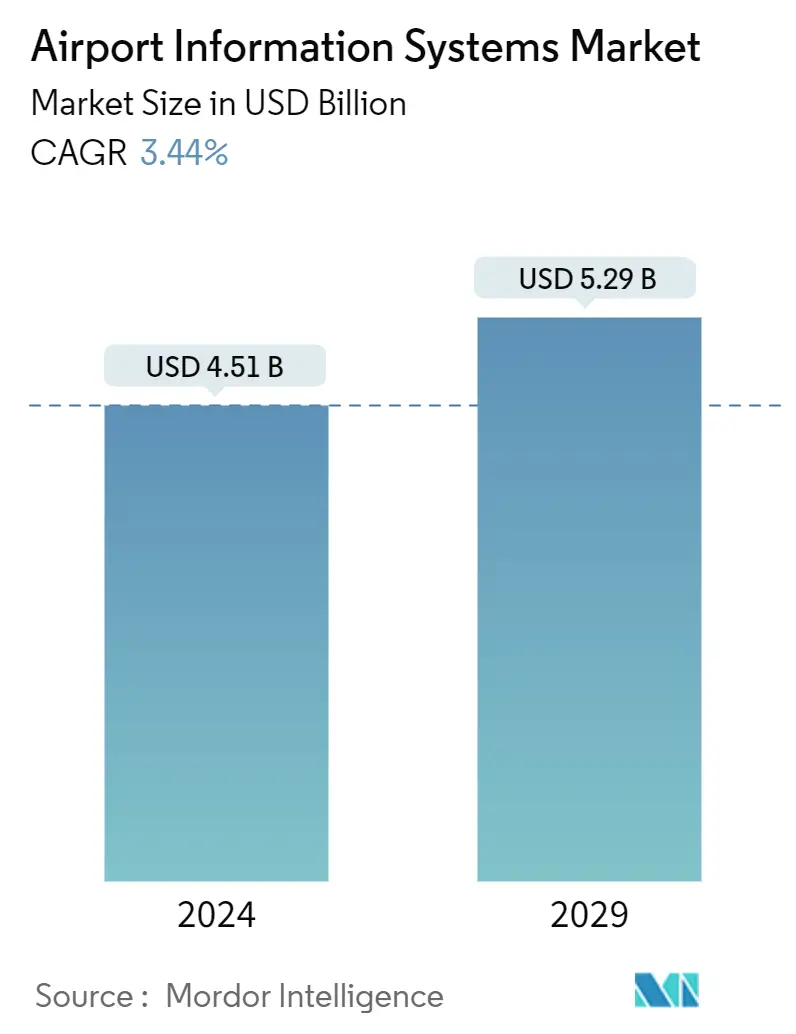Market Size of Airport Information Systems Industry

| Study Period | 2020 - 2029 |
| Market Size (2024) | USD 4.51 Billion |
| Market Size (2029) | USD 5.29 Billion |
| CAGR (2024 - 2029) | 3.44 % |
| Fastest Growing Market | Asia Pacific |
| Largest Market | North America |
Major Players
*Disclaimer: Major Players sorted in no particular order |
Need a report that reflects how COVID-19 has impacted this market and its growth?
Airport Information Systems Market Analysis
The Airport Information Systems Market size is estimated at USD 4.51 billion in 2024, and is expected to reach USD 5.29 billion by 2029, growing at a CAGR of 3.44% during the forecast period (2024-2029).
The COVID-19 pandemic severely impacted global passenger traffic in 2020 and 2021. The aviation industry started improving in 2022 and gradually returned to its pre-COVID-19 level. According to the latest updates from IATA, ICAO, the Airports Council International (ACI), the UN World Tourism Organization (UNWTO), the World Trade Organization (WTO), and the International Monetary Fund (IMF), the international air passenger traffic in 2022 has improved compared to that of 2021. The international air passenger traffic in June 2022 increased by 229.5% compared to June 2021, and the revenue passenger kilometers (RPK) in June 2022 reached 65% of the level in June 2019.
The number of people opting for air travel has increased in the past few years, which has resulted in increased pressure on airports and airlines to opt for advanced systems that can enhance their ground operations and support their goal of reducing aircraft turnaround time. Moreover, to improve efficiency and connectivity, upcoming airports use a variety of technologies, including integrated sensors for temperature and lighting monitoring, smart baggage tags for tracking and directing luggage to the aircraft, biometric check-ins with facial recognition, and cargo warehousing management. Airports are using technologies such as artificial intelligence (AI) and predictive analysis for a wide range of applications, from customer service to operational efficiency. Thus, the integration of such technologies to create an outlook of the operations of an airport and measure performance with associated key performance indicators (KPIs) is anticipated to drive the airport information systems market.
Airports are moving toward centralized architecture to meet the need for information sharing among different parties efficiently. Scanners and monitors are connected to airport systems, and hackers can easily gain access to internal systems through these physical assets. Data from the airport is collected, stored, and distributed daily, based on requirements that are vital for the airport to operate effectively. With regulations and systems becoming more complex, it is a huge task for manufacturers to keep up with appropriate security measures. However, there is a prominent threat of cyberattacks on airports that can lead to widespread disruptions of services. According to a study by the European Aviation Security Agency (EASA), there are an average of 1,000 airport cyberattacks per month. The exploitation of such security vulnerabilities may limit the scope of the integration of airport information systems during the forecast period.
